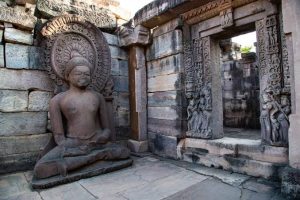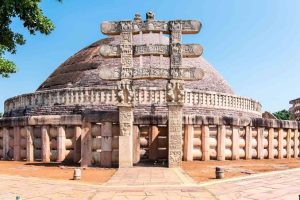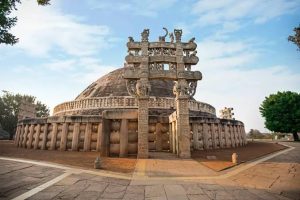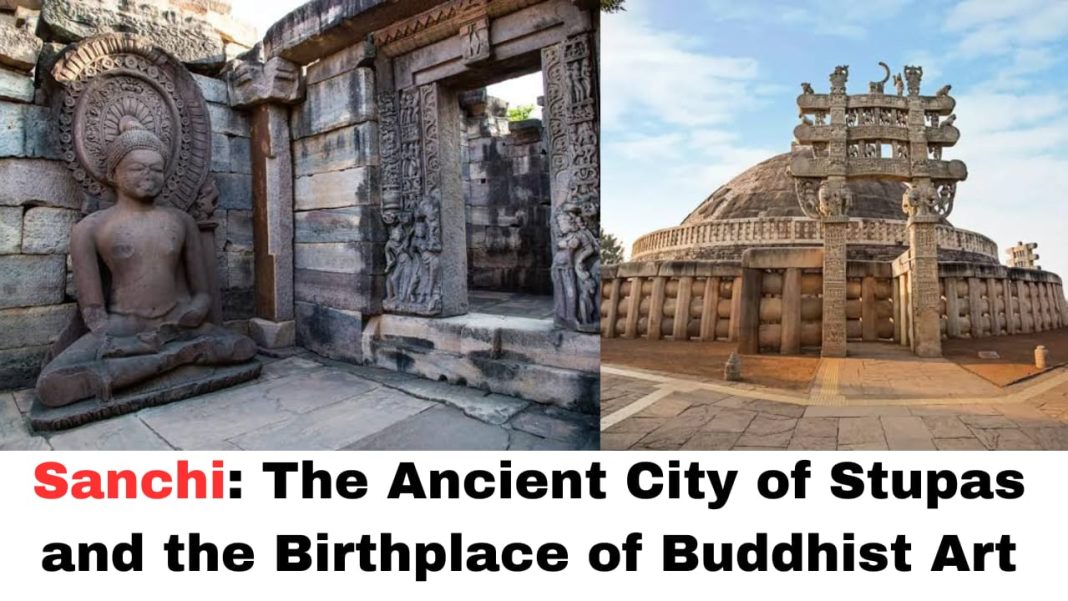Digital News Guru Education Desk:
Sanchi: A Jewel of Indian Heritage and Buddhist Architecture
Sanchi, located in the state of Madhya Pradesh, India, is one of the most significant archaeological sites in the country. Renowned for its Buddhist monuments, it offers a unique glimpse into ancient India’s architectural, artistic, and spiritual heritage. Often referred to as the “City of Stupas,” Sanchi is famous for its stupas, temples, and gateways, which represent the pinnacle of Buddhist architecture from the 3rd century BCE onwards. Its historical and cultural importance has earned it a place as a UNESCO World Heritage Site.
Historical Significance
The history of Sanchi dates back to the Maurya Empire in the 3rd century BCE, under the patronage of Emperor Ashoka. After the Mauryan period, Sanchi continued to be an important center of Buddhism throughout the Gupta period (4th-6th centuries CE), during which many of its monuments were constructed or expanded. The site became a flourishing hub for Buddhist teaching, pilgrimage, and monastic life.

Sanchi’s historical significance lies not only in its religious and cultural importance but also in its architectural innovations. The stupas and monastic complexes at Sanchi played a key role in the spread of Buddhism throughout India and beyond, particularly influencing Buddhist architecture in Southeast Asia and Central Asia.
The Stupas of Sanchi
The heart of Sanchi is its stupas, with Stupa 1 being the most famous and the largest of all the structures. Stupa 1, often called the Great Stupa, was originally commissioned by Emperor Ashoka in the 3rd century BCE. It is a hemispherical structure that enshrines relics of the Buddha and serves as a symbol of his teachings and enlightenment. The Great Stupa is one of the best-preserved and most iconic examples of early Buddhist architecture.
The stupa is surrounded by intricately carved stone gateways, known as toranas, which depict scenes from the life of the Buddha, the Jataka tales, and symbolic representations of Buddhist teachings. These toranas are masterpieces of sculpture and are regarded as some of the earliest examples of narrative relief in Indian art. The carvings on these gateways offer valuable insights into the religious and cultural life of ancient India, with scenes of the Buddha’s birth, enlightenment, and death, as well as symbolic representations of the Buddha’s presence, like the tree or the wheel.
Apart from Stupa 1, there are several other stupas at Sanchi, including Stupas 2 and 3, each with its unique history and artistic characteristics. The stupas at Sanchi represent different periods of Buddhist architecture, from the early Mauryan to the later Gupta style, showcasing the evolution of Indian religious and architectural practices over time.

Temples and Monasteries
In addition to the stupas, Sanchi is home to several temples and monasteries that further contribute to its historical and spiritual importance. Among the temples, the most notable is the Gupta-period Temple 17, which was dedicated to the Buddha. This temple is unique because it incorporates the architectural features of earlier structures, such as the use of a central sanctuary and a circumambulatory path.
There is also Temple 18, a structure from the 5th century CE, which is famous for its elaborate carvings and sculptures, particularly those depicting the Buddha and various bodhisattvas in serene, meditative poses. These temples reflect the importance of the Buddha’s teachings in the region, showing the fusion of religious devotion with artistic expression.
Sanchi also has a number of monasteries (viharas), which were used by Buddhist monks for meditation, study, and community living. These monastic complexes were equipped with cells for the monks, as well as assembly halls for teaching and rituals. The remains of these monasteries give insight into the monastic life of ancient Buddhist communities and the role of such institutions in preserving and spreading Buddhist philosophy.
The Toranas (Gateways)
One of the most striking features of Sanchi is its toranas, or monumental gateways, which are adorned with exquisite carvings. These gateways, positioned at the four cardinal points around the Great Stupa, are not only architectural masterpieces but also rich in symbolic meaning. They mark the boundary between the sacred and the profane and serve as a visual representation of the teachings of the Buddha.

The carvings on the toranas depict episodes from the Buddha’s life, such as his birth, enlightenment, and the first sermon. These representations were instrumental in illustrating the story of the Buddha to a largely illiterate population and in promoting the ideals of Buddhist practice. The toranas are also notable for their detailed depiction of flora, fauna, and daily life, offering valuable glimpses into the ancient world.
Art and Sculptures
The sculptures at Sanchi are some of the finest examples of early Indian art. The carvings on the stupas and gateways are highly detailed, with depictions of gods, goddesses, mythical creatures, and everyday life. These sculptures blend symbolic elements with narrative storytelling, offering an artistic reflection of Buddhist beliefs and practices.
The Buddha is never depicted in human form in the earliest stages of Sanchi’s construction, a characteristic of early Buddhist art. Instead, his presence is symbolized through objects such as the lotus, the wheel (Dharmachakra), or the tree (Bodhi tree). This style gradually evolved, and later sculptures at Sanchi do depict the Buddha in human form, but always with serene and meditative expressions, reflecting the Buddhist ideals of peace and enlightenment.
The carvings also include depictions of the Jataka tales—the stories of the Buddha’s previous lives—as well as scenes of everyday life, such as animals, traders, and farmers. These provide a rich historical context and are a valuable source of information about the social and cultural milieu of the time.
Sanchi Today: Preservation and Tourism
Today, Sanchi is a popular tourist and pilgrimage destination. The site has been preserved through the efforts of the Archaeological Survey of India, which has worked to protect and restore the ancient structures. It draws visitors from around the world who come to experience its serene atmosphere, historical significance, and the beauty of its art and architecture.

The site also continues to be a symbol of Buddhism’s enduring legacy in India and around the world. As one of the best-preserved archaeological sites of its kind, Sanchi plays a crucial role in preserving the heritage of Buddhism and showcasing its influence on Indian architecture, art, and culture.
Conclusion
Sanchi stands as a testament to the profound impact of Buddhism on India’s history and culture. The stupas, temples, monasteries, and sculptures at Sanchi not only embody the architectural brilliance of ancient India but also reflect the spiritual and philosophical depth of Buddhist teachings. As a UNESCO World Heritage Site, Sanchi continues to inspire scholars, pilgrims, and tourists alike, serving as a vital link to India’s rich cultural and religious past. Whether for its artistic beauty, historical importance, or spiritual significance, Sanchi remains a jewel of Indian heritage.
You May Also Read: Action, Emotion, and Drama: The Making of Salman Khan’s Sikandar








